By Ajay Chauhan, Co-founder, SalezShark
If there’s one thing I’ve learned after years of building and scaling SalezShark, it’s this: Building a sales-tech product isn’t about stuffing it with features, integrations, or flashy dashboards. It’s about solving real problems for real salespeople.
When we first started SalezShark, I was driven by the same energy that fuels most startup founders: a vision to change how sales is done. We saw a gap between what traditional CRMs were offering and what sales reps actually needed. Too many tools were being built for reporting, not selling. Too much time was spent on managing data, not conversations. And that, to me, was the core problem.
Fast forward to today, we’ve worked with thousands of businesses, processed millions of interactions, and continually evolved the product based on real-world feedback. Here are some of the biggest lessons I’ve learned along the way:
1. Talk to Your Users Like They’re Your Product Designers
In the early days, we spoke to every client personally. We asked what they liked, what they hated, what they wished existed. You quickly realize no one understands the day-to-day pain of sales better than the person on the front lines.
Many of our best features—like automated follow-ups based on engagement signals, or the ability to create dynamic contact lists based on behavior—came directly from these conversations. The more we listened, the more we understood that our users didn’t want “more features.” They wanted less noise, more impact.
2. Simplicity Sells, Complexity Kills
There’s a tendency in SaaS to equate value with complexity. But real users hate that. A product that takes a month to onboard or requires five tutorials before someone sends their first campaign will fail—no matter how powerful it is.
We focused on keeping SalezShark intuitive. If someone couldn’t send their first email campaign in under 15 minutes, we knew we had work to do. Good sales-tech should feel like a co-pilot, not a cockpit.
3. Sales and Marketing Should Not Be Siloed
This one’s personal. As someone who’s seen both sides of the coin, I can tell you that when sales and marketing tools don’t talk to each other, leads fall through the cracks. Opportunities get missed. Teams point fingers.
That’s why we built SalezShark Connect+ to unify the marketing and sales engine. A marketer can launch an email campaign, and the sales rep can see in real-time who clicked, who responded, and who needs a follow-up. It’s not just alignment; it’s intelligent handoff.
4. Automation Works, But Only When It Feels Human
Automation is not about sending more emails. It’s about sending the right message at the right time without manual effort. But here’s the catch—no one wants to feel like they’re talking to a robot.
Our automation workflows were designed to mimic real conversations. We built in delays, personalization, trigger-based content—so that the prospect feels like they’re part of a dialogue, not a blast.
5. Your Data Is Only As Good As Your Filters
We often get asked how we manage and deliver 8M+ verified B2B contacts. The truth is, having a huge database is meaningless if users can’t extract exactly what they need.
We learned to give users powerful yet simple filters—by geography, industry, designation, engagement level. Because targeting is everything. A well-timed message to 100 right people beats a generic blast to 10,000.
6. Founders Should Stay Close to the Funnel
This is a big one. As co-founders, it’s tempting to get lost in operations, funding, hiring. But some of the best product improvements I’ve driven came from sitting in on sales calls, reading user complaints, or watching how someone struggles during onboarding.
Founders have intuition. But intuition sharpened by real data? That’s gold.
7. Customer Support Is Not a Department. It’s a Culture.
Early-stage or late-stage, if your team doesn’t genuinely care about solving customer problems, you’re going to bleed churn. We made it a habit to over-support users. Live chat. Email check-ins. Follow-up calls. Not because it’s a KPI. But because we want people to feel like they’re not just buying a tool—they’re buying a team.
Final Thought: Real Tech Serves Real People
If you’re building or using a sales-tech product, remember: it’s not about flashy AI claims, or dashboards that look like a spaceship. It’s about clarity, usability, and outcomes.
At SalezShark, we’re still evolving. We listen more than we build. We test more than we assume. And we always ask: Does this feature help someone sell better, faster, or smarter? If the answer is yes, it stays. If not, we scrap it.
Because in the end, the best sales-tech isn’t the one with the most bells and whistles—it’s the one people actually use.
Ajay Chauhan
Co-founder, SalezShark
Helping businesses sell with purpose, not pressure.

